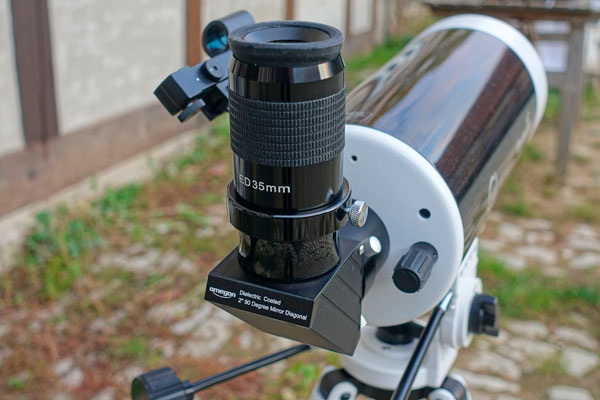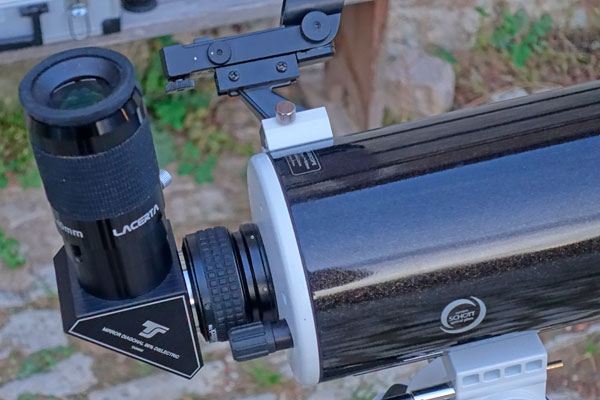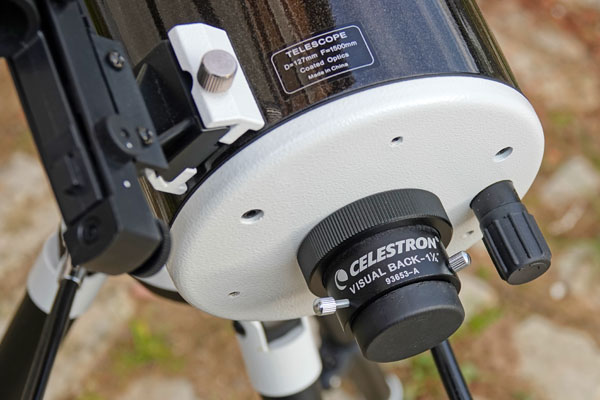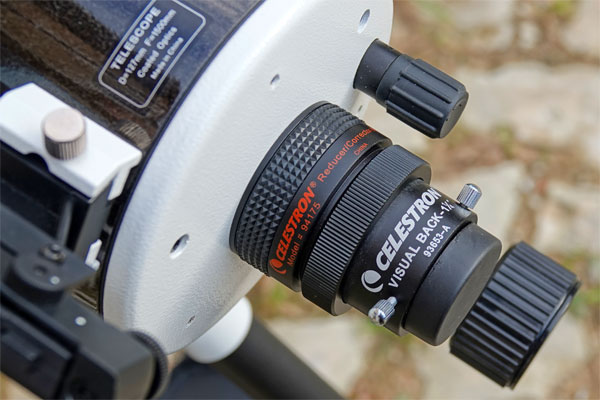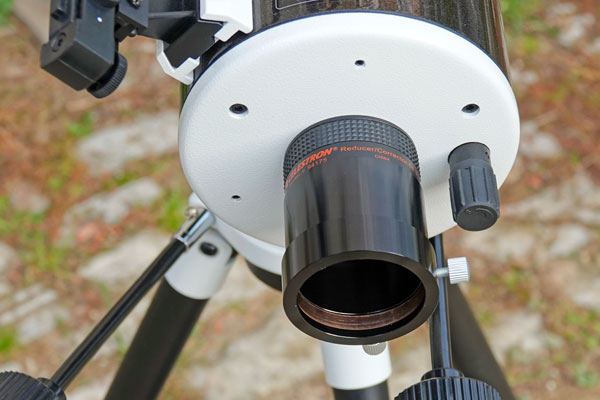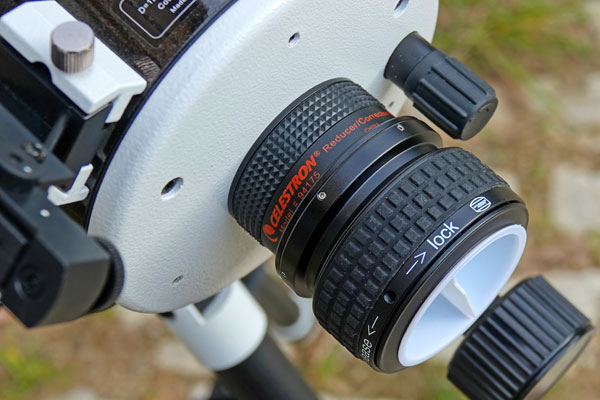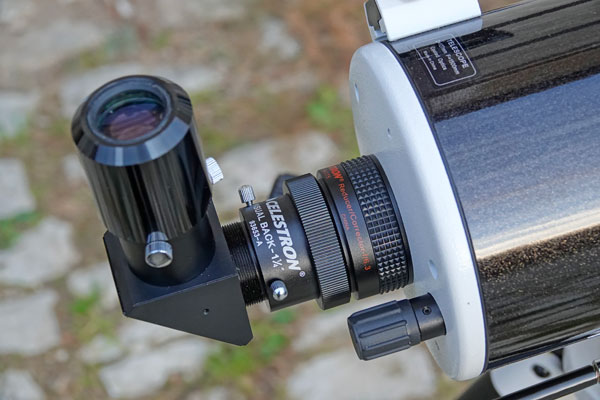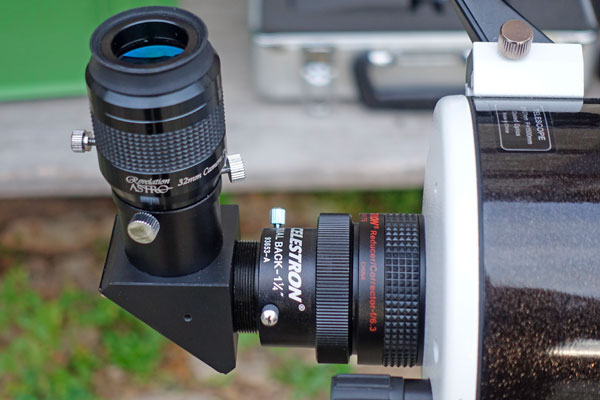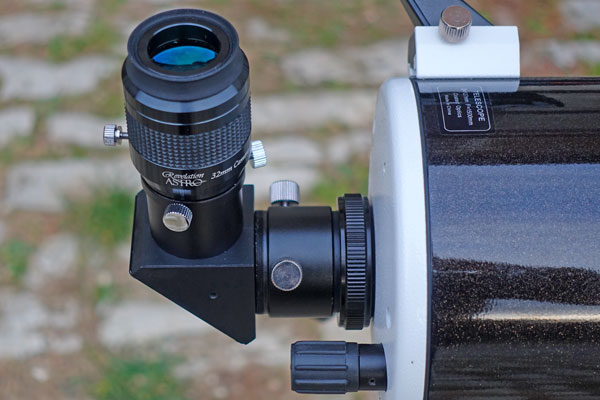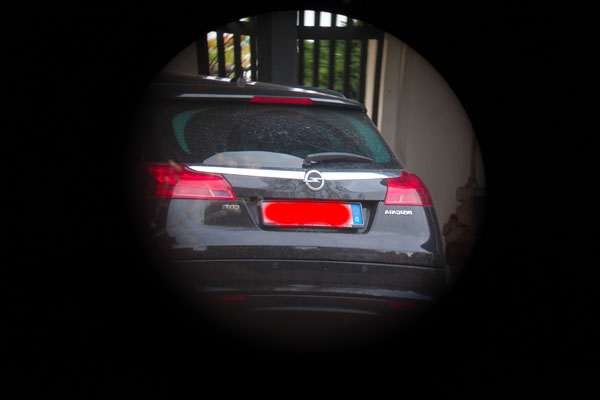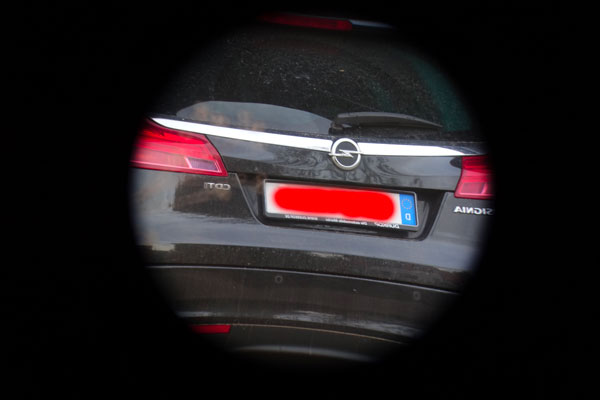Sky-Watcher Skymax-127 OTA - Further Experiences
Motivation and Questions | Adapters | Preliminary Conclusions | Links | Appendix: Data - Addendum
Archive
On this page, I present further experiences with my Sky-Watcher Skymax-127 OTA (BKM127OTA) (bought used on November 18, 2017; originally bought in August 2012; sold on January 30, 2021, rebought at the end of October 2021). It is a 127 mm/1500 mm (f/11.81) Maksutov-Cassegrain tube, which primarily is suited to observing the moon, the sun, and the planets; but it also suited to observing brighter DSO.
| Note: I sold my Sky-Watcher Skymax-127 OTA to a star friend at the end of October 2024. I therefore can no longer report any further experiences with this tube here. |
See also page Sky-Watcher Skymax-127 OTA (5" Maksutov-Cassegrain) Archive.
Motivation and Questions
At the end of October 2021, I bought back my Sky-Watcher Skymax-127 OTA, in order to use it in our vacation home. I then still have to transport the mount, eyepieces, and other accessories back and forth, but at least not the tube and a few parts that I only use at this telescope...
Can 2" Accessories Be Used at the Skymax-127?
After my experiences with the Celestron C5, it was obvious to also try out with the Skymax-127, whether this can be operated with 2" accessories. As with the C5, the discussions in the forums are controversial, but German astronomy dealers claim that this should be possible with certain restrictions (slight vignetting, which is hardly noticeable visually). Thus, an image circle of 40 mm would be illuminated and from 30 mm on the eyepieces are 2" eyepieces. Some time ago, Sky-Watcher changed the eyepiece connection and now explicitly allows the connection of 2" accessories. My model is older, but adapters for this are also offered on the market. More about this later!
Does the Celestron f/6.3 Reducer/Corrector also Work on the Skymax-127?
Because the C5 and the Skymax-127 are very similar tubes, it was natural for me to check whether the Celestron f/6.3 reducer/corrector would also work on the Skymax-127, and if so, how well. Of course, these reducers/correctors are designed for Schmidt-Cassegrain telescopes and not for Maksutov-Cassegrain telescopes, but why not try it out, I thought...
The Solution: Adapters
The Skymax-127 has a 1.25" connector on the eyepiece side ("visual back" as Celestron calls it...), which is attached to the tube with an M45 coupling nut. So, in order to be able to clarify the above questions, I needed one or even more adapters.
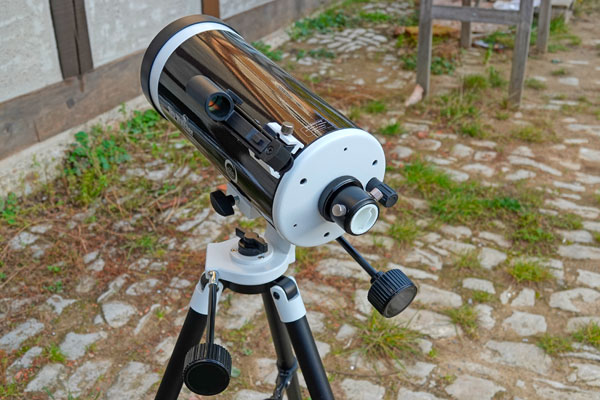 |
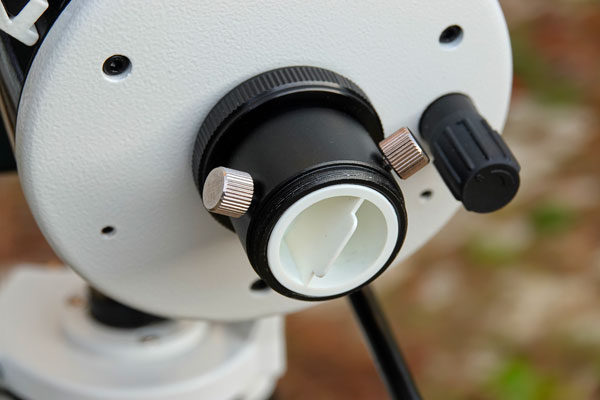 |
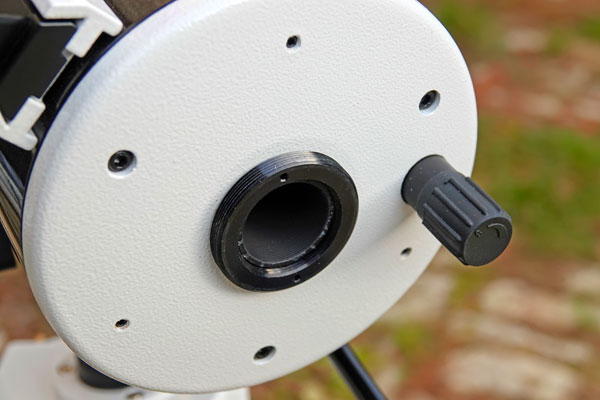 |
||
Skymax-127 with... |
... its 1.25" connector |
1.25" connector removed - you can see the M45 thread |
Photos: 1.25" connection at the Skymax-127
I was not able to find a direct connection for this thread to a 2" connector, but I found an adapter, or better, a ring that has an inner M45 thread and an outer SC thread. With this adapter, the whole SC world was opened for me! And for the 2" connection, I found an adapter that actually consists of two adapters, namely the said M45/SC adapter and an SC/2" adapter, thus allowing the transition to 2" accessories. More about this in the following!
The M45/SC adapter also allows the connection of an f/6.3 reducer/corrector to the Skymax-127, and thus a reduction in focal length. Whether this would bring exactly the factor 0.63 was part of my tests (see below). First, however, the tests had to reveal whether the image quality is sufficient.
Adapters
Preface...
The German astronomy dealers Astroshop and Teleskop-Service state (translated):
Skywatcher and Orion offer good and inexpensive Maksutov-Cassegrains from 100 mm aperture to 180 mm aperture. The telescopes allow the use of eyepieces up to about 40 mm field diaphragm diameter. However, eyepieces from 30 mm field diaphragm diameter are already 2" eyepieces.
With the 1.25" adapter, which is included with the telescope, you give away valuable field of view. This problem is solved by this TSSKM-2 adapter, which makes your telescope fit for the attractive 2" offer.
In other words, this adapter solves my problem! Moreover, it allows the connection not only of 2" but also of SC accessories. While the reason for this was not clear to me at Teleskop-Express, it became clear to me at Astroshop:
The adapter consists of two parts, the adaptation from Maksutov-Cassegrain to SC and the adapter TSSC-2* with a robust ring clamp.
*) 35 € at Teleskop-Service
The M45/SC adapter is a ring with an inner and an outer thread. I found it only in the version from Orion (Orion OR52067, 42 €), but this ring was not available. By the way, the corresponding ring used in the TSSKM-2 adapter looks the same. The TSSKM-2 adapter was available at Astroshop (45,90 €), but not at Teleskop-Service (38 €). So I bought it a bit more expensive, but still cheaper than if I had bought both adapters separately. Well, in 2021 shopping for astronomy accessories is not that easy...
Look of the Adapter and of Baader ClickLock 2"
So I ordered a TSSKM-2 adapter from Astroshop at the end of October 2021 and received it promptly. Afterwards, I tried different possibilities and took photos of them:
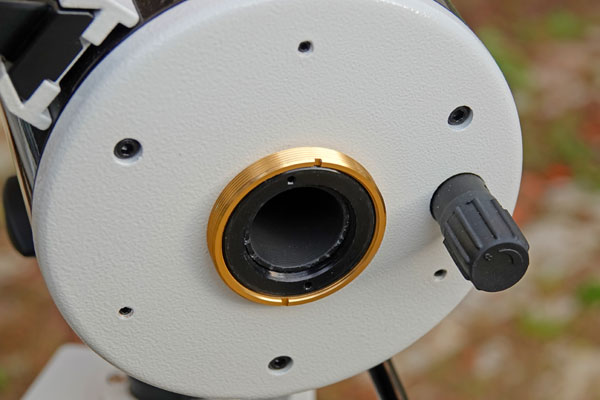 |
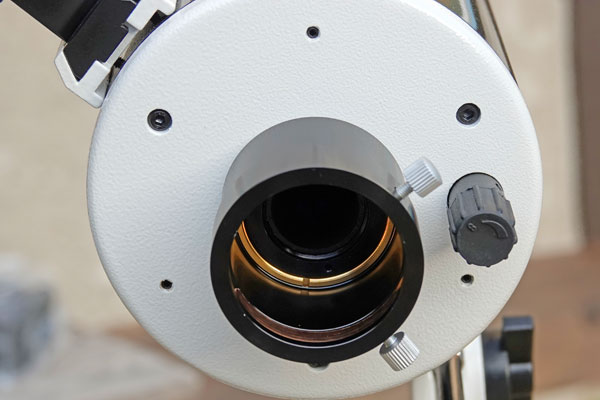 |
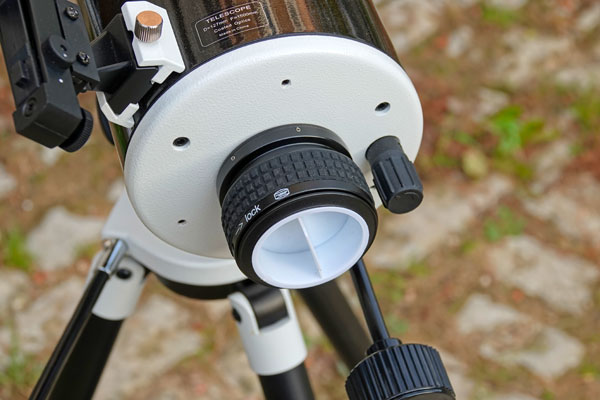 |
||
M45/SC adapter screwed onto the M45 thread |
TSSC-2 adapter for 2" accessories screwed on (this results in the TSSKM-2 adapter...) |
Baader ClickLock for 2" accories screwed on the M45/SC adapter |
The photo on the left shows the solution for connecting SC accessories (the M45/SC adapter). The photos in the middle and on the right show two alternative solutions for connecting 2" accessories to the Skymax-127: The TSSKM-2 adapter consisting of two parts (the M45/SC adapter and the TSSC-2 adapter) in the middle and on the right the connection via Baader ClickLock for SC thread (screwed onto the M45/SC adapter).
Theoretically, you could also screw the Celestron 1.25" Visual Back onto the M45/SC adapter. But first of all it "rattles" (but there would be suitable spacer rings available...) and secondly you can have the same effect already with the 1.25" connector of the Skymax-127.
So now it was time to test, which of these solutions works at all on the Skymax-127. To say it in advance: All of those that I tested do work!
Tests with both SC-to-2" Adapters (ClickLock and TSSC-2)
All my three 2" eyepieces (26 mm, 35 mm, and 40 mm) deliver a sharp image with both adapters. I could hardly detect any disturbing vignetting, but I did not test this thoroughly. I was not able to not take any photos of the vistas because the camera used vignetted (especially when stopping down during shooting).
However, I found one difference between the two adapters. I was not able to fully insert the 2" sleeves of my two 2" Zenit mirrors into the Baader ClickLock adapter (see photo above to the right). This did not change the function, but I felt it was a small "blemish". Therefore, I decided to use the TSSKM-2 adapter for 2" accessories only on the Skymax-127 and continue to use the ClickLock adapter only on the Celestron C5 (for 2" accessories).
Increase in Focal Length
In discussion forums, I found that because of the longer light path, the focal length of the Skymax-127 increases when using 2" accessories. In order to check this for my equipment, I tested three conditions:
- With 1.25" zenith mirror and 32 mm eyepiece (1.25")
- With 2" Omegon zenith mirror and 32 mm eyepiece (1.25")
- With 2" TS zenith mirror and 32 mm eyepiece (1.25")
I measured a certain path in the photos, which was visible on all the three photos, using Adobe Photoshop Elements. Here are the results:
- 1.25" zenith mirror and 32 mm eyepiece (1.25"): 2672 pixels, corresponding to a focal length of 1500 mm
- 2" Omegon zenith mirror and 32 mm eyepiece (1.25"): 3035 pixels, corresponding to a focal length of 1704 mm
- 2" TS zenith mirror and 32 mm eyepiece (1.25"): 2967 pixels, corresponding to a focal length of 1666 mm
The increase in focal length when using a 2" zenith mirror is obviously quite large and a little larger for the Omegon zenith mirror than for the one from TS.
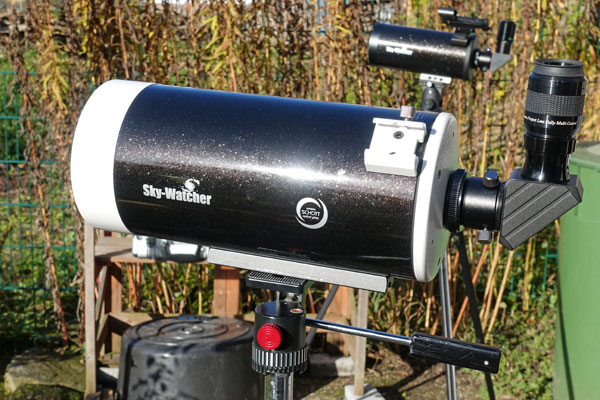 |
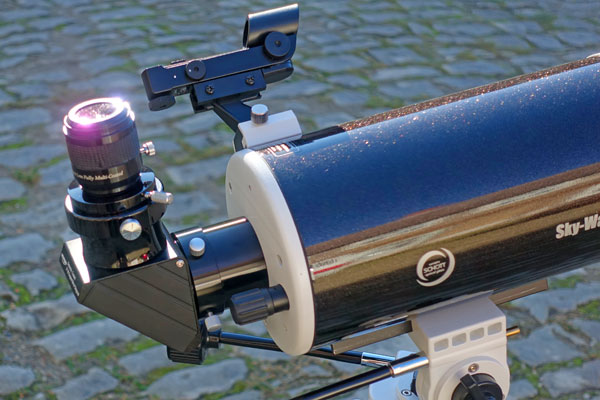 |
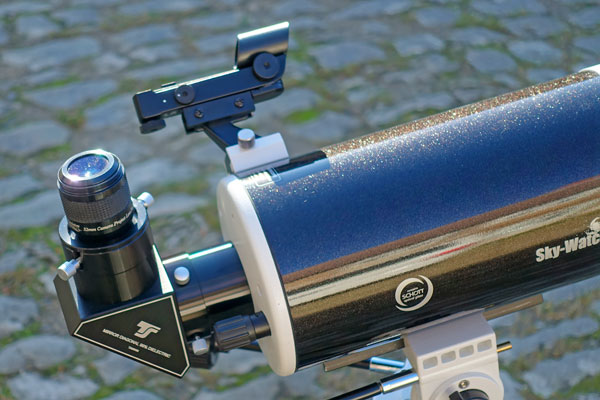 |
||
1.25" accessories (different 1.25" zenith mirror) |
Omegon 2" zenith mirror |
TS 2" zenith mirror |
||
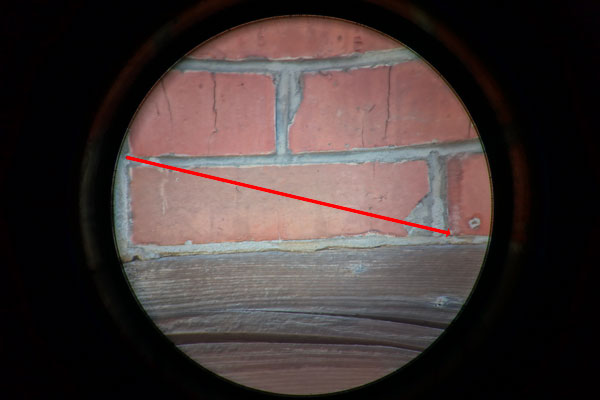 |
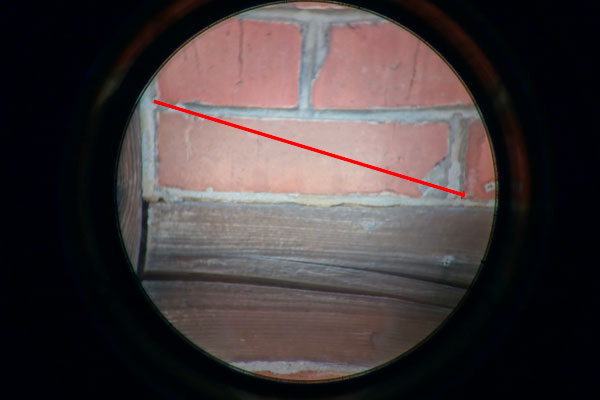 |
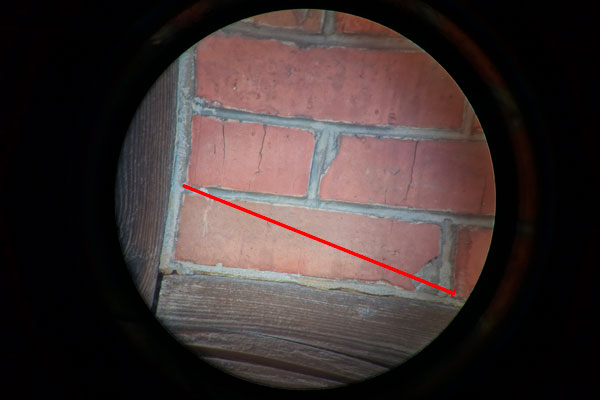 |
||
1.25" accessories |
Omegon 2" zenith mirror |
TS 2" zenith mirror |
If you roughly assume a focal length extension to 1700 mm, the gain in field of view by 2" accessories is reduced by a factor of 15/17, that is, roughly to 88% (or 90%, if it does not have to be sooo exact). So this would have to be taken into account for all field of view values!
Tests with the Celestron f/6.3 Reducer/Corrector
I also screwed the M45/SC adapter onto the Skymax 127 thread and then screwed on the f/6.3 reducer/corrector. I tested this with the Celestron zenith mirrors* with virtually all of my 1.25" eyepieces, was able to focus, and also did not find any distracting vignetting. I tested the Celestron Amici prism* with only a few eyepieces and also did not find any problems.
*) I reserved the simple zenith mirror and the simple Amici prism from Celestron for the Skymax-127 for the time being; I use the better zenith mirror and the Baader Amici prism on the C5. But it can also be that I will change my mind...
Reduction Factor
I took a comparison shot with and without the reducer/corrector to determine the reduction factor a few days later. Here are the results:
I measured 3 different distances on each of the two photos using the line tool in Adobe Photoshop Elements and came up with a size ratio of just under 0.65, which is close to the expected result of 0.63. So in the future I will calculate with the factor 0.63 for the sake of simplicity!
Note: I did not perform any tests with the reducer/corrector and 2" accessories (via one of the two adapters).
Preliminary Conclusions
My preliminary conclusion is that, similar to the Celestron C5, 2" accessories can be operated on the Skymax-127 without major problems. The same is true for the Celestron f/6.3 reducer/correcor. This would put the Skymax-127 on par with the C5 in terms of versatility! Further tests would have to clarify, which tube delivers the better image quality...
Since I was not able to fully insert the 2" sleeves of my two 2" Zenit mirrors into the Baader ClickLock adapter, I decided to use the TSSKM-2 adapter for 2" accessories only on the Skymax-127 and continue to use the Baader ClickLock adapter only on my Celestron C5 (for 2" accessories).
As with the Celestron C5, the Skymax-127 is most flexible when used with the f/6.3 reducer/corrector and can be used with all of my 1.25" eyepieces.
Please note that the gain in field of view by using 2" accessories is in part compensated by an in increase in focal length (about 90% of the calculated FOV values). According to my tables (see below), it looks like that, considering the increase in focal length, the field of view with my 2" eyepiece with 40 mm focal length is smaller than that of my 32 mm Plössl eyepiece (1.25").
Links
- Sky-Watcher Company Website, USA: skywatcher.com
- Product page: skywatcher.com/product/bk-mak127sp-125/
- Pages from German distributors for the Sky-Watcher Skymax-127 OTA:
- Teleskop-Spezialisten: www.teleskop-spezialisten.de/shop/Teleskope/Maksutov-Cassegrain-MAK/100-145mm/Skywatcher-Skymax-127-OTA-127mm-1500mm-Maksutov-Teleskop::312.html (in German) - www.teleskop-spezialisten.de/shop//Maksutov-Cassegrain/100-145mm/::312.html?language=en (in English)
- Teleskop-Service/Express (here the telescope was bought): www.teleskop-express.de/shop/product_info.php/info/p2771_Skywatcher-Skymax-127-OTA---127-1500mm-Maksutov-Teleskop.html (in German) - www.teleskop-express.de/shop/product_info.php/language/en/info/p2771_Skywatcher-Skymax-127-OTA---127-1500mm-Maksutov-Teleskop.html (in English)
- Astroshop: www.astroshop.de/skywatcher-maksutov-teleskop-mc-127-1500-skymax-bd-ota/p,14981 (in German) - www.astroshop.eu/skywatcher-maksutov-telescope-mc-127-1500-skymax-bd-ota/p,14981 (in English)
- TS Optics Adapter for Maksutov Cassegrains on 2" (astroshop.eu): www.astroshop.eu/other-adaptors/ts-optics-adapter-for-maksutov-cassegrains-on-2-and-sports-club/p,11257
- TS-Optics 2" Adapter für Skywatcher & Orion Maksutov Cassegrain Teleskope: www.teleskop-express.de/shop/product_info.php/language/en/info/p286_TS-Optics-2--Adapter-fuer-Skywatcher---Orion-Maksutov-Cassegrain-Teleskope.html
- See also my page offering Astronomy Links.
Appendix Data for Sky-Watcher Skymax-127 OTA - Addendum
Visual Power (Magnification) and Other Data for Different Focal Lengths of Eyepieces (Mostly My Current Eyepieces)
Note: These tables include the StarTravel 120 refractor, a TSWA32 eyepiece (2", 32 mm focal length, 70° viewing angle) that I borrowed together with the StarTravel 120, a 18 mm eyepiece (2", 82° viewing angle), a 38 mm eyepiece (2", 70° viewing angle), and a 56 mm eyepiece (2", 52° viewing angle).
| Telescope | Further Data |
Focal Length of Eyepiece (mm) |
||||||||||||
| Magnification | ||||||||||||||
Focal Length of Telescope (mm) |
4 |
7 |
10 |
16 |
18 |
24 |
26 |
32 |
32 |
35 |
38 |
40 |
56 |
|
| PS 72/432 | 432 |
108.00 |
61.71 |
43.20 |
27.00 |
24.00 |
18.00 |
16.62 |
13.50 |
13.50 |
12.34 |
11.37 |
10.80 |
7.71 |
| ST120 | 600 |
150.00 |
85.71 |
60.00 |
37.50 |
33.33 |
25.00 |
23.08 |
18.75 |
18.75 |
17.14 |
15.79 |
15.00 |
10.71 |
| TLAPO1027 | 714 |
178.50 |
102.00 |
71.40 |
44.63 |
39.67 |
29.75 |
27.46 |
22.31 |
22.31 |
20.40 |
18.79 |
17.85 |
12.75 |
| 150PDS | 750 |
187.50 |
107.14 |
75.00 |
46.88 |
41.67 |
31.25 |
28.85 |
23.44 |
23.44 |
21.43 |
19.74 |
18.75 |
13.39 |
| SM127 | 1500 |
375.00 |
214.29 |
150.00 |
93.75 |
--- |
62.50 |
57.69 |
46.88 |
--- |
42.86 |
--- |
37.50 |
--- |
| SM127 (Red.) | 945 |
236.25 |
135.00 |
94.50 |
59.06 |
--- |
39.38 |
36.35 |
29.53 |
--- |
27.00 |
--- |
23.63 |
--- |
| SM102 | 1300 |
325.00 |
185.71 |
130.00 |
81.25 |
--- |
54.17 |
--- |
40.63 |
--- |
--- |
--- |
--- |
--- |
| C5 | 1250 |
312.50 |
178.57 |
125.00 |
78.13 |
69.44 |
52.08 |
48.08 |
39.06 |
39.06 |
35.71 |
32.89 |
31.25 |
22.32 |
| C5 (Red.) | 787.5 |
196.88 |
112.50 |
78.75 |
49.22 |
--- |
32.81 |
30.29 |
24.61 |
--- |
22.50 |
--- |
19.69 |
--- |
| C8 | 2032 |
508.00 |
290.29 |
203.20 |
127.00 |
112.89 |
84.67 |
78.15 |
63.50 |
63.50 |
58.06 |
53.47 |
50.80 |
36.29 |
| C8 (Red.) | 1280 |
320.00 |
182.86 |
128.00 |
80.00 |
--- |
53.33 |
49.23 |
40.00 |
--- |
36.57 |
--- |
32.00 |
--- |
| True Field of View (°) | ||||||||||||||
Apparent Field
of View (°) > |
82 |
82 |
72 |
82 |
82 |
65 |
70 |
52 |
70 |
69 |
70 |
68 |
52 |
|
Focal Length of Telescope (mm) |
4 |
7 |
10 |
16 |
18 |
24 |
26 |
32 |
32 |
35 |
38 |
40 |
56 |
|
| PS 72/432 | 432 |
0.76 |
1.33 |
1.67 |
3.04 |
3.42 |
3.61 |
4.21 |
3.85 |
5.19 |
5.59 |
6.16 |
6.30 |
6.74 |
| ST120 | 600 |
0.55 |
0.96 |
1.20 |
2.19 |
2.46 |
2.60 |
3.03 |
2.77 |
3.73 |
4.03 |
4.43 |
4.53 |
4.85 |
| TLAPO1027 | 714 |
0.46 |
0.80 |
0.91 |
1.84 |
2.07 |
2.18 |
2.55 |
2.33 |
3.14 |
3.38 |
3.73 |
3.92 |
4.08 |
| 150PDS | 750 |
0.44 |
0.77 |
0.96 |
1.75 |
1.97 |
2.08 |
2.43 |
2.22 |
2.99 |
3.22 |
3.55 |
3.63 |
3.88 |
| SM127 | 1500 |
0.22 |
0.38 |
0.48 |
0.87 |
--- |
1.04 |
1.21 |
1.11 |
--- |
1.61 |
--- |
1.81 |
--- |
| SM127 (Red.) | 945 |
0.35 |
0.61 |
0.76 |
1.39 |
--- |
1.65 |
1.93 |
1.76 |
--- |
2.56 |
--- |
2.88 |
--- |
| SM102 | 1300 |
0.25 |
0.44 |
0.55 |
1.01 |
--- |
1.20 |
--- |
1.28 |
--- |
--- |
--- |
--- |
--- |
| C5 | 1250 |
0.26 |
0.46 |
0.58 |
1.05 |
1.18 |
1.25 |
1.46 |
1.33 |
1.79 |
1.93 |
2.13 |
2.18 |
2.33 |
| C5 (Red.) | 787.5 |
0.42 |
0.73 |
0.91 |
1.67 |
--- |
1.98 |
2.31 |
2.11 |
--- |
3.07 |
--- |
3.45 |
--- |
| C8 | 2032 |
0.16 |
0.28 |
0.35 |
0.65 |
0.73 |
0.77 |
0.90 |
0.82 |
1.10 |
1.19 |
1.31 |
1.34 |
1.43 |
| C8 (Red.) | 1280 |
0.26 |
0.45 |
0.63 |
1.03 |
--- |
1.22 |
1.42 |
1.30 |
--- |
1.89 |
--- |
2.13 |
--- |
| Exit Pupil (mm) | ||||||||||||||
Focal Ratio |
4 |
7 |
10 |
16 |
18 |
24 |
26 |
32 |
32 |
35 |
38 |
40 |
56 |
|
| PS 72/432 | 6 |
0.67 |
1.17 |
1.67 |
2.67 |
3.00 |
4.00 |
4.33 |
5.33 |
5.33 |
5.83 |
6.33 |
6.67 |
9.33 |
| ST120 | 5 |
0.80 |
1.40 |
2.00 |
3.20 |
3.60 |
4.80 |
5.20 |
6.40 |
6.40 |
7.00 |
7.60 |
8.00 |
11.20 |
| TLAPO1027 | 7 |
0.57 |
1.00 |
1.43 |
2.29 |
2.57 |
3.43 |
3.71 |
4.57 |
4.57 |
5.00 |
5.43 |
5.71 |
8.00 |
| 150PDS | 5 |
0.80 |
1.40 |
2.00 |
3.20 |
3.60 |
4.80 |
5.20 |
6.40 |
6.40 |
7.00 |
7.60 |
8.00 |
11.20 |
| SM127 | 11.81 |
0.34 |
0.59 |
0.85 |
1.35 |
--- |
2.03 |
2.20 |
2.71 |
--- |
2.96 |
--- |
3.39 |
--- |
| SM127 (Red.) | 7.44 |
0.54 |
0.94 |
1.34 |
2.15 |
--- |
3.23 |
3.49 |
4.30 |
--- |
4.70 |
--- |
5.38 |
--- |
| SM102 | 12.75 |
0.31 |
0.55 |
0.78 |
1.26 |
--- |
1.88 |
--- |
2.51 |
--- |
--- |
--- |
--- |
--- |
| C5 | 10 |
0.40 |
0.70 |
1.00 |
1.60 |
1.80 |
2.40 |
2.60 |
3.20 |
3.20 |
3.50 |
3.80 |
4.00 |
5.60 |
| C5 (Red.) | 6.3 |
0.63 |
1.11 |
1.59 |
2.54 |
--- |
3.81 |
4.13 |
5.08 |
--- |
5.56 |
--- |
6.35 |
--- |
| C8 | 10 |
0.40 |
0.70 |
1.00 |
1.60 |
1.80 |
2.40 |
2.60 |
3.20 |
3.20 |
3.50 |
3.80 |
4.00 |
5.60 |
| C8 (Red.) | 6.3 |
0.63 |
1.11 |
1.59 |
2.54 |
--- |
3.81 |
4.13 |
5.08 |
--- |
5.56 |
--- |
6.35 |
--- |
Blue: Equipment borrowed for comparison purposes; gray: sold equipment; italic: 2" eyepieces
Magnification: Yellow: low (30-50 x); magenta: medium
(80-100 x); violet: high (150-200 x - and more); red: beyond
maximum usable magnification.
Exit pupil: Values in magenta cells are
either too small (< 1 mm) or too large (> 6.4/7 mm); yellow background:
best for galaxies (about 2-3 mm).
| 17.11.2024 |

